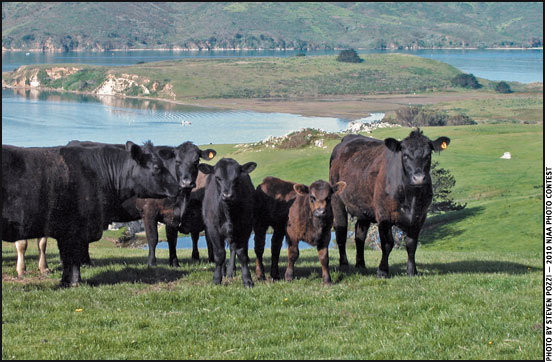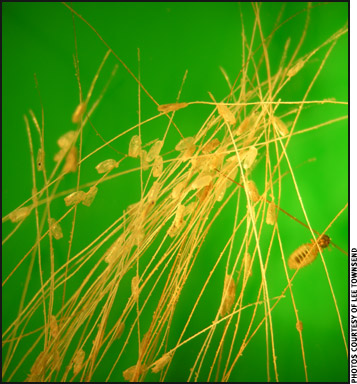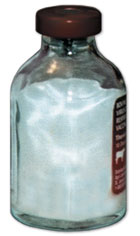HEALTH & NUTRITION...

Calfhood Vaccinations
Some vaccines have been shown to provide some immunity at an early age, even in the presence of maternal antibodies.
We don't know how much maternal immunity each calf gets, and it will wane at different times for each animal, says Mark Alley, clinical assistant professor at North Carolina State University. "It's also going to be different with various bacteria or viruses. So vaccine recommendations will be very dependent on what the potential issues are on each farm."
Alley notes that researchers have discovered there are a few viruses — specifically infectious bovine rhinotracheitis (IBR), bovine respiratory syncytial virus (BRSV) and parainfluenza-3 virus (PI3) — that may not be blocked by maternal antibodies as much as once thought. Read more.
A Lousy Situation
Discomfort, restlessness and time spent rubbing due to a lice infestation can interrupt normal feeding, hindering performance and, potentially, increasing susceptibility to disease.

Lice have legs adapted to clinging to hair and must remain on a host animal to survive.
Cattle in the U.S. are subject to attack by multiple species of lice. Biting lice feed on skin particles and skin excretions, while sucking lice feed on blood and serum. Species of the latter type are usually considered a greater threat to cattle performance and health, since they cause blood loss. Lice of any kind can be a nuisance.
Lice cause skin irritation and itching, prompting cattle to rub on trees, fences, feeders or buildings and cause costly damage. As a result of repeatedly scratching their itch, lice-infested cattle usually rub out patches of hair and may rub themselves raw. Discomfort, restlessness and time spent rubbing can interrupt normal feeding, hindering performance and, potentially, increasing susceptibility to disease.
According to University of Kentucky (UK) Extension entomologist Lee Townsend, the potential for economic loss becomes greater when lice and other factors combine for a cumulative effect.
"Moderate to heavy infestations add to the impact of cold weather, shipping stress, inadequate nutrition, or harm from internal parasites or disease," says Townsend. "The interaction between low levels of both lice and intestinal nematodes (worms) can reduce weight gains by more than 8%. The energy that lice 'steal,' coupled with other factors, can have a severe impact on animal health. Manifestations can be anemia, slow recovery from disease, poor gains or general unthriftiness."
Editor's Note: For the full story, including why conditions this winter were favorable to lice infestations, how to identify lice species, how to control lice and a description of a louse species that is becoming more problematic in the summer, subscribe to the Angus Journal at https://www.angusonline.org/Journal/JrnSubscr.aspx
Research Will Focus on Health, Efficiency in Feedlot
Research teams receive $14 million to study feed efficiency in cattle, bovine respiratory disease.
The United States has the world's fourth-largest cattle population. More than 970,000 farms raise beef cattle, contributing to a $71 billion retail value. Yet, farmers and feedlot operators spend millions of dollars every year feeding some cattle that don't grow efficiently. Simultaneously, when cattle are brought together in feedlots, they can be exposed to bovine respiratory disease, leading to significant economic losses and reduced animal well-being.
Now, with the help of two grants totaling more than $14 million from the National Institute of Food and Agriculture, part of the U.S. Department of Agriculture, research teams led by investigators from the University of Missouri and Texas A&M University will combine their resources to battle these two problems. Read more.

Rick Rasby
Ridin’ Herd
What size fits?
With high input costs, cattle producers continually refine and evaluate how resources are being allocated. Because feed costs make up the largest portion of annual cow costs, producers look to attack feed costs to make their livestock enterprise competitive. As producers re-evaluate feed inputs, revisiting items that drive nutrient needs of beef cows is a good first step.
Beef cattle geneticists make the statement that cow type needs to fit the feed resource of your operation and that different biological types fit better in high-stress and low-stress environments. Feed resources differ from ranch to ranch, and not all cow types will excel in a particular production system. Read more.
TVMDL Confirms Anthrax Case
Sample tissue submitted to the Texas Veterinary Medical Diagnostic Laboratory (TVMDL) has tested positive for anthrax in a central Texas beef cattle herd, according to agency officials. In late March, the Texas Animal Health Commission (TAHC) confirmed the anthrax case on a ranch in Hill County near Whitney, 30 miles north of Waco. A veterinarian submitted the tissue samples to the diagnostic laboratory in College Station.
"It's not unheard of, but somewhat unusual (for anthrax to be discovered in Central Texas)," said Amy Swinford, head of diagnostic bacteriology for the TVMDL. Read more.
Managing BRD in High-Risk Cattle
Combine a veterinarian-developed treatment plan with proper management to reduce illness.
Veterinarian Doug Hilbig of Lakin, Kan., quickly recognizes cattle at high risk for bovine respiratory disease (BRD). He can tell by their appearance trouble is brewing.
"With these cattle, you can tell by their appearance when they arrive or through history that they're going to be high-risk cattle," he says. "High-risk cattle often also have severe nutritional or health challenges. You can tell when they get off the truck."
To head off BRD before it starts, Hilbig works with his producers to develop a plan and then helps train everyone on the operation in advance of the arrival of high-risk cattle — helping ensure cattle are healthy and that the operation is maximizing its time. Read more.
 Tips for Handling Vaccines
Tips for Handling Vaccines
Vaccine effectiveness depends on proper handling.
"If you're working a bunch of cattle over a 6- to 8-hour period, mix it up as you go and make sure the vaccine is protected from sunlight," he advises. "UV (ultraviolet) light can have a detrimental effect on vaccine, particularly the modified-live vaccines." Keep it cool, but also out of direct sunlight. Be sure to keep the lid on the insulated container. In cold weather, make sure the vaccine doesn't freeze. Read more.
Cattle Diseases: Common Conditions/Terms
Click here for a list of common conditions and terms related to beef cattle diseases, such as anaplasmosis, brucellosis, BVD, E. coli, IBR and others.
[Click here to go to the top of the page.]













